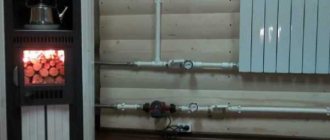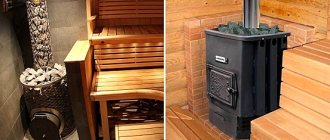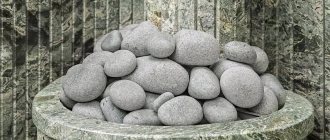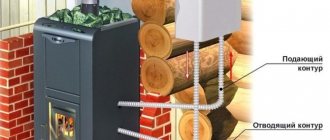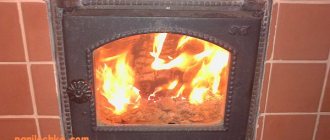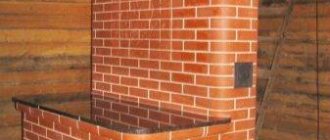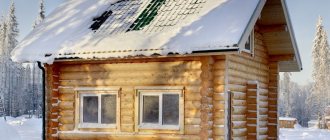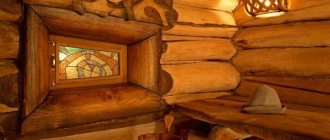The construction of a traditional Russian bath requires a special approach and the use of special heat sources that can relatively quickly warm up the steam room space to a high temperature. For this purpose, boilers for wood-burning saunas are used, which have a special design that allows them to transfer maximum heat into the room.
Sectional view of a boiler for a bath
The power of a wood stove is a significant parameter
The technical characteristics of sauna stoves always indicate the volume of the room for which the power of a particular stove model is calculated. As a rule, the range indicated is from 6 to 12 cubic meters. or from 12 to 24 cubic meters. etc. However, in this case it is not enough to simply multiply the height, length and width of the steam room. The fact is that to determine the volume of the steam room when choosing the required furnace power, there are some nuances.
- If you plan to heat the stove in winter, then add 30% to the resulting volume. In this case, the volume will better match the suitable oven power.
- If the steam room has surfaces that do not have a thermal insulation coating (concrete, brick, glass, etc.), then when calculating for each square meter of surfaces made of similar materials, another 1.2 m3 of volume should be added. For example, the volume of a steam room is 10 m3. Inside there is a glass door 0.8 meters wide and 2 meters high. Calculations: 10+2x0.8x1.2 = 11.9. It follows that the stove should be selected for a room with a volume of 12 m3.
- If the walls are made of massive logs, then the calculated cubic capacity must be increased by 1.5 times.
And now, the main thing is that the stove is selected to suit the size of the steam room only! Many bathhouse attendants strive to heat the entire bathhouse with a stove and, accordingly, are based on the size of the entire bathhouse. We will talk about whether it is possible to heat an entire bathhouse with a stove in our next article.
The above calculation rules are suitable for most steam rooms, where the interior decoration is made of clapboard with thermal insulation underneath. If you have some large panels made of salt, for example, or the decor takes up a lot of space, or the insulation is made of stone, then an individual calculation is required.
Making a wood-burning boiler for a sauna
The first step is to prepare a place to place the equipment: strengthen the floor covering. Materials used:
- Fireclay brick;
- Asbestos cardboard, more than a centimeter thick;
- Metal sheet, one millimeter thick.
Do-it-yourself wood-burning boiler for a sauna with a tank.
The base is made smooth and durable. For the manufacture of the chimney, only non-combustible materials are used. On the outside it is additionally covered with thermal insulation. It is important to know: the junction of the heating device with the chimney pipe is made collapsible.
The manufacturing process consists of three stages: preparation of materials, welding of supports, creation of a screen.
Materials
Having chosen a boiler in a cylindrical bathhouse, use a metal barrel of 200 liters. A thick pipe with a diameter of half a meter and a length of up to a meter will do.
Also prepare:
- Reinforcement 14 mm thick, making three sections of 3 cm each for supports.
- Metal sheet 4 mm thick;
- Metal sheet 5 mm thick;
- Bricks and cement.
Assembly
We weld three supports parallel to the body. The first one, the bottom one at the very bottom. The middle one is located depending on the location of the blower door. The third is 20 cm lower from the top of the body.
- Next, cut out the bottom and lid from sheets of metal. We make a hole in the chimney ring in the lid.
- We make a hole in the side of the body for the box. We install oven and blower doors there.
- Inside the box we make a partition for the compartments. And we make a screen: we lay out a brick wall or completely cover the boiler.
- We leave a hole at the bottom for air convection. But first, we weld the box into a barrel or pipe.
- Insert the bottom, lid, grate. We install a chimney.
Even if you save on self-assembly of a boiler for a bath, a lot of money and time will be spent on purchasing and searching for materials, not to mention installation work. If your site has a centralized gas supply, it is better to use more modern heating equipment.
The location of the stove or design features of the steam room
Pay special attention to one point: where the stove will be fired from. And it can be heated either from the steam room itself, or from the dressing room, washing room, locker room, rest room, etc. Such stoves are called “remote” or with a remote fuel channel.
Where to heat from is a matter of your taste. If you want to heat the stove without leaving the steam room, then choose a stove model without an external firebox. But if you don’t want to, and if the design of the bathhouse allows you to heat the stove from the adjacent room, then choose a stove with a remote firebox.
As you consider what is best for you, be sure to consider the following. “Takeaway” stoves retain oxygen in the steam room, as they take it for combustion from another room. But at the same time, you will have to run out of the steam room from time to time to check the condition of the firebox and the amount of firewood. And, of course, while you open and close the door, the heat will leave the steam room.
Let us also note the difficulty of installing a stove with a remote firebox compared to stoves without a remote firebox. But this cannot be called a serious disadvantage. If you have the hands and expert advice, then anything is possible. As the authors of the article, we recommend that you contact our specialists and order not only a suitable stove, but also an installation service.
By the way, we do not recommend placing the firebox outside! Call us and we’ll explain why: 8 (812) 605-85-05.
Fig 1. Oven Vesuvius Legend “without removal” (left and center) and Vesuvius Legend “with removal” (right)
Heating boilers using liquid diesel fuel
A diesel heating boiler requires a separate room, because
When burning, it produces an unpleasant odor. Bath boilers that run on liquid diesel fuel are considered second in convenience after gas boilers. After all, there is no problem with storing fuel here either - it is enough to find capacious metal or plastic containers, preferably with dense double walls, because diesel fuel can deteriorate its physical properties when stored for more than 1 year.
For a diesel fuel boiler, a separate room in the bathhouse must be allocated - otherwise all other rooms will become saturated with an unpleasant odor. However, some craftsmen purchase several tons of fuel at once and bury it in tanks in the ground, refilling them only once a year. But this can only be done under the guidance of an experienced person.
Today there are also homemade boilers for baths that run on liquid fuel . But before installing such a boiler, it must be shown to a specialist.
Stove doors: if you want to admire the fire, consider the nuance
Everything is simple here. The door of a wood stove can be solid or glass. Of course, the glass door will allow you to enjoy the view of a live fire and at the same time control the availability of firewood in the stove. It is important to consider the following: if you have a stove without an extension, and the steam room is small, then the glass door can burn your feet with infrared radiation from the firebox of the stove. In this case, we recommend that you refuse this “bonus” and give preference to solid doors.
By the way, there is a story that through a glass door it will be possible to partially heat the room into which it opens. It is a myth. Of course, the door will transfer heat into the room, but it is so insignificant that it can be ignored.
Device specifics and functionality
The bathhouse is built mainly separately from the main housing, so it is equipped with its own boiler and heating circuit. If you install a double-circuit model with a boiler, hot water will always be available. The downside of the solution is that in winter you will have to make sure that no water remains in the system; every time you use the steam room, it needs to be filled and drained.
If you are planning a sauna with a stove-heater, a single-circuit boiler will be sufficient; in this case, the water for hygiene procedures will be heated separately. When arranging a sauna, you should ensure that the equipment has two circuits - for servicing the water in the pool and for heating the bath rooms. When the complex has a swimming pool, the heating system can be organized using several methods:
- autonomous heating, powered by solar panels or a heat pump;
- heat exchanger and pump combined in a heating circuit;
- pumping antifreeze into pipes;
- installation of a flow heater with a heating element.
The priority is given to electric sauna boilers, which are supplied with a complete set of piping:
- circulation pump;
- filter designed for fine cleaning;
- thermostat;
- expansion tank;
- safety valve.
An example of an electric boiler for a bath.
A useful option will be auto-shutdown elements that are triggered in an emergency: when a pressure drop or overheating occurs. The possibility of switching from summer to winter mode is welcome; in this case, energy savings are realized.
Furnace firebox material: cast iron, boiler (09g2s), stainless or black steel
The material from which the firebox is made is an important characteristic of a wood stove. Two main metals are used - steel (ferrous, boiler, stainless) or cast iron. Let's look at them in more detail.
Black (structural) steel for furnace heating is the most inexpensive material with a short service life (no more than 7-10 years).
This steel is the least heat-resistant (400°C). The temperature inside the firebox of a sauna stove reaches 500-600 degrees Celsius. Feeling a problem?
Heat resistance is the ability of a material to withstand high temperatures without breaking. After exceeding its thermal resistance limit, the material begins to deteriorate.
To compensate for the low heat resistance of this material, black steel fireboxes are made with a thickness of at least 5 mm (or even 6, 8, 12 mm).
By the way, inexperienced bathhouse builders and sellers mistakenly believe that the greater the thickness, the better, although in reality in this case the thickness is associated only with the low heat resistance of the material.
Boiler steel 09g2s is the same structural steel, but with the addition of alloying elements.
In other words, it is a low-alloy steel, which in terms of properties occupies a middle position between black steel and stainless steel.
Artemenko Vyacheslav Manager of the store on the street. Kollontai, 18
Alloying elements are special additives that increase the heat resistance of steel.
The heat resistance of such material is within 500 degrees Celsius. Accordingly, it also needs to be compensated for by thickness, but less.
Please note that although the thickness of boiler steel fireboxes is no more than 3-5 mm, the service life of such stoves can be longer than black steel fireboxes. Therefore, there are brands that prefer this material. For example, the Grill'D company produces all its oven models from this kind of steel (except for the PRO models, which are made of stainless steel).
Stainless steel is, of course, the strongest and most heat-resistant steel.
Generally, the standard thickness with competitive price is 2mm. At the same time, the heat resistance of steel is 800 degrees, which means that scale will not form under any circumstances. In fact, the heat resistance of the material allows us to make fireboxes even thinner, but in this case the thickness of 2 mm is due to the mechanical load that the stove must withstand.
Note that there are also professional models made of stainless steel, the thickness of which can be 4 and 6 mm. The service life of such furnaces is 15, 20 or more years. But such models, of course, will cost more.
Cast iron is an almost ideal material, but there is one “but”...
An inexperienced specialist will claim that cast iron is the ideal material for making a firebox. This is partly true - cast iron is the most durable metal and practically does not burn out, and with proper operation the stove will last 10 years or more. But there is one drawback - it is fragility!
And here the phrase “When used correctly!” comes first. For example, with sudden temperature changes, cast iron can simply burst, but steel fireboxes are not afraid of such an outcome under any circumstances.
In terms of price, cast-iron wood-burning stoves will cost you a little more than stoves made of black or boiler steel (20-25 percent). But there are, of course, professional expensive models that are comparable in price to steel stoves with a thickness of 4-6 mm.
To compare the cost of stoves made from different materials, use the stove selection filter.
Recommendations for choosing a boiler for a steam room
If you have chosen a traditional type of fuel for yourself - wood, then the choice of a boiler for a bath in your case will be made between two options: a steel or cast iron body of the unit. Cast iron is a fragile material, so when choosing a boiler made of this material, you need to make sure that there are no thin parts in the design. During long-term use, thin cast iron elements can simply break. It is necessary to ensure that the wood-burning boiler for a Russian bath made of cast iron has massive door hinges, handles for opening them and other parts. It is worth inspecting the working surface of the combustion chamber and the rest of the body casting for manufacturing defects in the form of cracks or chips.
Cast iron boiler for a bath
Wood-burning stoves for steam rooms are presented on the market by several domestic and foreign manufacturers. Among them, the presence of Finnish brands such as NARVI or KASTOR is natural. As a rule, Finnish sauna boilers are made with high quality and do not cause any complaints during operation. The only requirement that must be met, regardless of the type of unit purchased, is to ensure good draft of the chimney pipe. Without this, the furnace will never reach its designed capacity and will not be able to heat your room to a high temperature. If the draft is too high, the problem can be solved by closing the damper, but the lack of draft is much more difficult to correct.
When choosing a boiler, you should pay attention to the chimney duct inside the unit. It is desirable that it has as few bends and turns as possible on its way out. This is especially true for steel units, since the temperature of the flue gases in them is high and in places of greatest resistance the metal will burn more intensely.
Finnish sauna or Russian bath? Determining the heater
The type of heater determines the moisture temperature regime, which means you will have to choose what you like best: a classic Russian bath or a Finnish sauna.
Artemenko Vyacheslav Manager of the store on the street. Kollontai, 18
The Russian bath is characterized by high humidity (60%) at moderate air temperatures (60-65 degrees Celsius).
The Finnish sauna, on the contrary, is characterized by high air temperatures (90, 100 and above degrees Celsius) with minimal humidity (10-15%, less often 20%).
The principle of creating a temperature regime in a steam room due to the type of heater is quite simple. Let us remember physics: the hotter the surface on which water falls, the fewer moisture particles (fractions) are formed.
Open heater - stones lie “on top”. The stones are open to the eye, so they come into contact with air, and as a result they cool down. This heater creates a temperature regime close to a Finnish sauna. The temperature of the stones when water is supplied is within 200, maximum 250 degrees Celsius. When water hits the stones, it forms coarse-grained steam (like steam from a boiling kettle), tubers of smoke are formed, which make it difficult to breathe.
Closed heater - stones are hidden in a compartment. The stones are kept in a closed place - this is a special, usually metal, compartment in a sauna stove. Such stones are enveloped in fire from all sides and become very hot (400-450 degrees Celsius). When water is applied to such stones, finely dispersed steam is formed, which feels light and “soft”. This heater dries quickly and recovers.
Combined heater. The design of the stove is made in such a way that there is both a visible, open part, and a closed, inner part of the heater. In such models, the open part of the heater performs more of a decorative function. The main supply of water goes to the closed part, forming light, fine steam. If you wish, you can, of course, supply water to the open heater, but the steam, again, will be harsher. Note that the open heater in such models additionally plays the role of a convector that extinguishes infrared radiation.
Fig 2. Types of sauna stove heaters
Power control mechanisms
One of the main criteria for choosing equipment for a bath is temperature control tools. There are only 2 scenarios on the specialized market: stepped and smooth.
Models operating on the basis of several heating elements usually provide stepwise power adjustment. To change the operating mode of such a boiler, it is necessary to activate or turn off some of the heating elements. Depending on how many of them will be involved in the work, you can set 4 power levels from 25% to 100%.
Step power adjustment
But judging by user reviews, smooth adjustment is more comfortable and economical, since it can be used to set specific temperature parameters. A smooth transition between indicators is ensured using a rheostat.
You can find budget models on sale that are characterized by low power and do not provide adjustment tools at all.
Types of furnaces
Self-installation of a stove in a bathhouse requires good preparation. Before deciding to purchase expensive equipment, homeowners consider all the pros and cons. There are many different types of metal stove devices on the market. Here are just a few that can be used as a sauna stove:
- with a firebox opening into the steam room;
- with a firebox that opens into the dressing room;
- with a firebox loaded from the street;
- with vertical or horizontal loading;
A variety of choices will help you choose the stove for your bath that is right for you.
- with or without a container for stones;
- with or without water tank;
- round;
- prismatic;
- multi-level;
- with a chimney outlet through the wall or through the ceiling.
In addition to metal stoves, there is the option of installing brick stoves. A homeowner faced with so many choices can be overwhelmed
Usually, first of all, pay attention to the following characteristics:
- unit size;
- what fuel it consumes;
- Efficiency - how long one firebox lasts;
- speed of heating and cooling.
From this video we will learn typical mistakes when installing stoves and chimneys in a bathhouse:
It should be borne in mind that the iron version can be easily combined with the brick one. Very often, the installation of a sauna stove is completed by covering it with ceramic bricks. Read also: how to line an iron stove in a sauna with bricks.
Selection and preparation of material
Of course, it is necessary to select and prepare materials even before making the boiler. Iron barrels with a volume of about 200 liters are usually used as the main structural element, but you can select a piece of thick-walled pipe with a diameter of 51 cm and a length of 70 to 100 cm. As practice shows, such a homemade boiler from a pipe into a bathhouse is capable of heating a room with a volume of about 15 cubic meters.
Before work, you will also need to prepare a tool. You will definitely need a small welding machine and a grinder with discs for cutting metal. In addition, you will need detailed instructions for assembling a specific boiler circuit. It will not be superfluous to familiarize yourself with the photos that show all the stages of boiler assembly.
Designs with built-in or mounted water tank
A water heating tank is a metal container of a certain volume into which cold water is initially poured and during the heating process of the furnace it is heated.
A hanging tank, which is located on the other side of the stove (in some cases even in another room) is not always convenient. Also dubious is the pleasure of washing from the tank, which is built into the stove body.
Firstly, it is impossible to control how much water is left and whether it needs to be added. Secondly, constantly boiling water produces too much steam, which is not very comfortable for a small steam room.
Advantages of a remote water tank
Any storage container in a bathhouse can be heated in one of two ways - either from the firebox itself or from the chimney pipe. The remote tank can only heat up through the pipes leading from the furnace coil. The disadvantage of the design is the need to be close to the stove (no more than 300 cm), but for most steam rooms this is enough.
Example of a remote water tank
In general, heating water in a bathhouse can be organized systematically - if the tank is large, the best location would be a chimney, when the passing hot smoke heats the water. Small storage tanks can be installed directly on the heater, but then it is necessary to organize a good steam outlet. It is advisable to install small tanks outside the steam room.
Some practical tips
To avoid unproductive losses of thermal energy, the boiler must be insulated. Wrap it with foil rolled mineral wool, leaving no gaps. The thickness of the wool should be at least 10 cm.
To calculate boiler power there is no need to use complex formulas. Practice shows that to heat one square meter of room in the southern regions, 100÷120 W is enough, in the northern regions approximately 150÷200 W are needed. Based on these data, select the power of the heating elements.
Circulation pumps are marked on the body indicating the diameter of the connecting thread, maximum lift height, power, permissible installation length of pipelines and channels of heating batteries
Approach the choice of a specific brand of pump carefully, pay attention to all its indicators and technical characteristics. Buy pumps with a reserve, do not allow them to operate at limit values
The power reserve of approximately 30% doubles the operating time of the equipment.
Circulation pump
If you plan to install a heat exchanger in a solid fuel boiler, then under no circumstances increase the combustion time of the fuel. The heat transfer of fuel per unit time can decrease so much that the heating temperature of the coolant will be insufficient to heat the premises. Anyone can make a boiler and radiator according to their own drawings; it is impossible to determine the optimal combustion parameters in advance; you will have to go by experience. In order to avoid problems during the operation of the sauna boiler, make all heating elements with a power reserve.
Homemade heat exchanger
Heat exchanger made of cast iron radiator
We make a sauna boiler with our own hands
Before making a homemade boiler for a bathhouse, you need to choose the desired design so that it fits the intended installation site, develop drawings or borrow them from friends who already have a bathhouse boiler that has proven itself well in operation.
Worst case scenario, you can take an option from the Internet. It is desirable that it includes not only drawings, but also photos and video materials, as well as operating instructions. After choosing a design, the necessary materials and tools are selected from the drawings.
List of materials and tools
In order to make your own boiler for a bathhouse from a pipe, you need to prepare the following materials and tools:
- Bulgarian;
- locksmith kit;
- steel fittings of different diameters;
- steel pipes of the proper length and cross-section;
- steel hinges for hanging doors on the boiler body;
- tank tap for heating water;
- asbestos cord for sealing the pipe;
- pipe for removing flue gases, the diameter of the boiler pipe.
Blueprints
To make a boiler for a bath from a pipe, drawings and diagrams are used. Using them, parts of supports, doors, grates, a heat exchanger are cut out on the metal, and a piece of pipe for the combustion device is cut. Separately, a section is cut out from a pipe of a smaller diameter for arranging a chimney in the bathhouse.
Making supports
In order to properly install the boiler in the bathhouse, each functional area of the unit must be separated by a steel partition along the diameter of the combustion space.
To install the partitions, you will need to install stops inside the housing made of 12 mm steel reinforcement, after which they are inserted into the pipe and welded in the proper position.
From the inside, the pipe must be laid out into working sections with height dimensions:
- ash chamber up to 100 mm;
- firebox for baths up to 400 mm;
- for placing a heater up to 400 mm;
- for a hot water tank up to 600 mm.
From below, the bottom is welded hermetically around the circumference, and support legs made from pieces of channel are welded to it. A homemade sauna stove must be stable.
Firebox
The best type of material for it is considered to be a thick-walled 8-10 mm pipe over 500 mm. It is possible to use less thick metal, for example, an ordinary barrel, but its service life will be much shorter.
Photo source: Pavelpechi.rf. https://www.youtube.com/watch?v=-9pvd3BC89M&feature=emb_title
Photo source: Pavelpechi.rf.
Algorithm for executing a firebox for a bath unit:
- Cut the pipe according to the drawing for the firebox.
- The bottom and top of a 10 mm sheet are welded to the boiler.
- To give the unit stability, it is necessary to weld channel legs to the bottom.
- Use a grinder to accurately cut out the ash pit. The removed part of the metal is used to make the blower door.
- A handle and hinges are attached to the door and hung on the body.
- A grate is installed above the ash pan. You can use a factory cast iron grate or simply a steel sheet of the required configuration, with holes capable of allowing ash deposits to pass through.
- Having departed the distance from the grate according to the drawing, another rectangular hole is made to install the firebox door. It is equipped with hinges and a handle and is hung on the body.
- The heater is located directly above the firebox. Its height is taken to be similar to the firebox. It is fenced with a mesh structure to hold stones.
Photo source: Pavelpechi.rf.
Heat exchanger
In most cases, the heat exchanger is made in the form of a water jacket with an external or internal location. The former are made in the form of a closed separate container inside the combustion chamber, and the latter are attached to the structure of the firebox from the outside, to which pipes are welded for coolant circulation. There are also external heat exchangers installed outside the chimney.
Assembly of the structure
After all the elements of the boiler have been manufactured and installed in place, they begin to implement the smoke ventilation system. The exit point of the chimney is determined in advance in order to avoid unnecessary turns in the future.
In places where they bend, chimneys burn out very quickly. Therefore, it is recommended to use special two-layer sandwich systems. This will also limit the direct contact of wooden sauna structures with hot chimney systems.
Before installing the boiler in the bathhouse, it can be painted to give it an aesthetic appearance. For these purposes, special heat-resistant polymer paint is used.
However, such a coating will not last long, since the burning temperature of firewood is about 600 C. Therefore, even thermal paint will need to be updated frequently, and its price is quite high. In connection with this, many craftsmen finish it in the form of a brick sauna stove.
Photo source: Pavelpechi.rf.
Installation
Before installing the boiler, prepare a site for placement. It must be made of concrete or brick. The boiler is placed in such a way that the wooden cladding has a fireproof clearance of at least 500 mm, and in front of the boiler front there is a free clearance of at least 100 cm. The walls are protected with screens made of basalt materials.
The boiler is connected to a smoke ventilation system and a circuit for heating and hot water systems. An automation and safety system is installed on gas and liquid fuel units.
On solid fuel boilers - a security system consisting of sensors for temperature, pressure and gas pollution in the room. After completing the piping, perform pressure testing of the assembled circuit along the water line with operating pressure, checking for possible leaks.
Types and types of tank placement
Depending on the type of materials, there are two types of stoves with a tank:
- Metal. Made from cast iron or stainless steel. Manufacturers offer square, rectangular, cylindrical and other units. The devices are inexpensive and do not require a foundation. The disadvantage is poor resistance to temperature changes.
- Brick. A practical option. They retain heat for a long time and have a long service life. To install them, it is necessary to build a reliable foundation.
Tanks for sauna stoves come in the following types:
- Remote. One of the most optimal locations. This allows you to quickly heat the water and maintain the desired temperature in the steam room. Moisture does not spread until it warms up. Most people place the tank in an adjacent room and connect a register so that the water is heated by the stove.
- Built-in. The reservoir is installed above the firebox or on the side of the stove. The shape of the container is most often rectangular. In this case, the wall thickness is 0.8-1.5 cm. The reservoir is filled with water through a special hole. You have to regularly pour hot water into the tanks and add cold water, since they do not tolerate temperature changes well.
- Mounted. An airtight container with a lid and a tap to drain the water. Installed on one of the walls of the stove. Usually made of stainless steel, as this material can withstand heavy loads. The container is attached to the oven wall using hooks or loops. It is convenient to install and remove. This option is great for small baths.
- Added. Original view of the bank. The pipe is welded at an angle from the stove to the bottom of the tank. The container is placed above the stove. Heating occurs as follows: liquid from the bottom passes into an inclined pipe and boils. Bubbles form, rise up the pipe and burst when they find themselves in cold water. In this way, heat is transferred and convection is formed.
- Chimney (samovar). One of the most common, but not the most practical tanks. Hot air passes through a pipe in the center of the body and heats the water. Reservoirs come in a variety of shapes. The main disadvantage is the location. It is inconvenient to fill in water, since the filler hole is located high.
Differences between furnaces and boilers
The first thing you need to do before installing a boiler in a bathhouse is to have a good understanding of the classification of such systems, their features and functions. It will not be superfluous to look at photos of various designs and their diagrams in order to understand how an electric boiler for a bath differs from, for example, a gas boiler.
It is important when studying to be sure to note the main difference between a metal boiler and a traditional brick oven. Often inexperienced people spread the erroneous claim that these designs are completely identical. But the difference is obvious, and it lies, firstly, in the material used for construction, and secondly, in the manufacturing scheme and operating principle of the compared systems.
Otherwise, both cast-iron boilers and ordinary sauna stoves are similar, since the functions assigned to them are absolutely the same - creating heat and steam, as well as heating water and stones.
Advantages and disadvantages of a homemade bath unit
Despite the fact that a self-made sauna boiler does not always look aesthetically pleasing, it nevertheless copes with its functions perfectly - it heats the steam room quite quickly and efficiently, creating the desired temperature in it, and heats hot water for washing.
The manufacture of such a stove has a number of advantages, the main ones being the availability of materials, low cost and the ability to use any design geometry to suit the actual conditions in the bathhouse. A tube furnace with a firebox also has excellent heat capacity.
The disadvantages include the high inertia of heating and cooling. In the event of an emergency, the boiler will remain dangerous until all the fuel burns out. In addition, this design has a rather low combustion chamber volume, which will require frequent addition of firewood or coal. As can be seen from this article, in fact, making a boiler for a wood-fired sauna with a water tank yourself is quite possible for a home craftsman who knows how to handle metalwork and welding tools, and to obtain therapeutic steam you just need to fill the heater correctly.
Long combustion heating boilers
The newest types of boilers for baths are solid fuel boilers with long combustion. Their distinctive feature is a significant period of burning solid fuel with just one load. In some models this period reaches even 5 days.
Wood and drinkers are excellent fuel for such boilers, although in some models mixtures of coal, firewood and peat can be used. After all, the operating principle of such a boiler is ingeniously simple: the mechanism that supplies air descends from top to bottom, depending on the stage of smoldering of the loaded fuel. Thus, during operation, the boiler constantly maintains the temperature set for it and independently changes the air supply, and, therefore, the intensity of fuel combustion - using a draft regulator.
Long-burning boilers do not produce excess heat, and therefore do not require a storage tank. The most popular boilers today are the Lithuanian company Stropuva.
The main thing in choosing a boiler is a guarantee for the duration of its operation.


